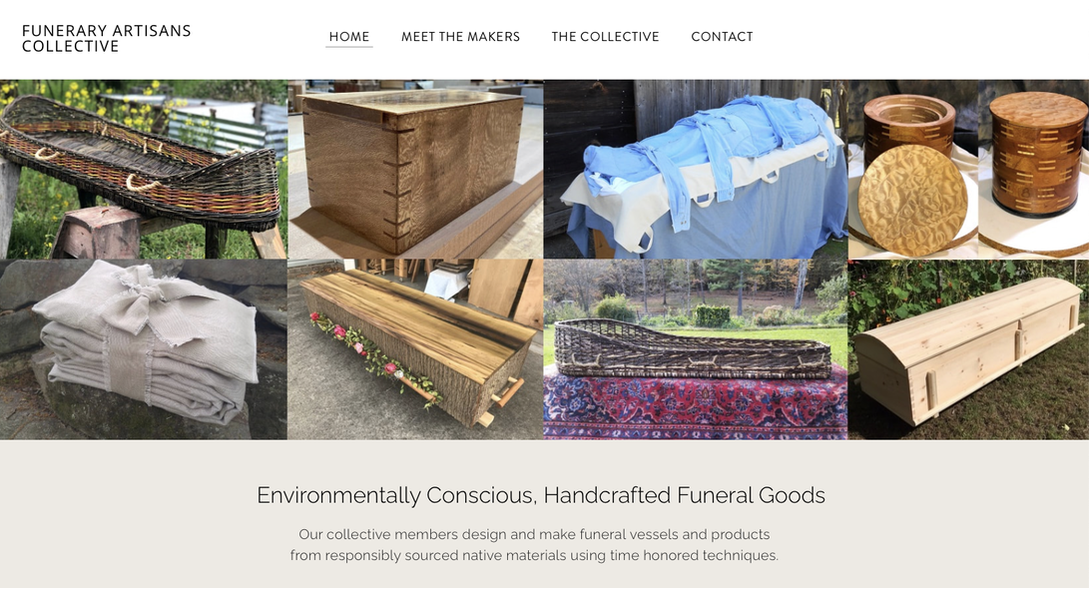- Home
- How To
-
Resources
-
Green Burial
- Green Burial in NH
- Green Burial Cemeteries in the US and Canada
- Conservation Burial
- Start Up Tips for Green Burial Cemeteries
- 10 Things You Can Say or Do to Promote Natural Burial
- Offering Green Burial in Your Hybrid Cemetery
- Natural Burial Bylaw Language
- Legal Burial Requirements by State
- New Hampshire Embalming Law
- Green Burial Survey
- Photographs
- Green Burial Books
- Presentations
- Websites
- Contact
Approaching Funerals with an Eco-ConscienceMany of us try to minimize our impact on the planet, but we may not know how to do so when it comes to decisions about dying and the disposition of our bodies. When faced with the task of finding an environmentally responsible final exit strategy, we may be thrust into a situation where the available choices don't match our values. New and old, methods of disposition and memorialization are changing to meet our increasing demand for affordable, eco-friendly, and meaningful practices. You may not be able to do it all, but even doing some contributes to the shift toward more sustainable funeral practices.
|
On This Page
|
Green Disposition Options
What to do with the deceased’s body after death? There are pros and cons, from an eco-friendly point of view, with both new and old disposition options, whether burial, cremation, or alternatives that are emerging. The Green Burial Council is a resource for more information regarding green burial options nationwide (see Green Burial Defined), and an emerging range of Other Disposition Options. (See How to Arrange Disposition for an overview of options presently available in New Hampshire.)
Some ideas include:
Some ideas include:
- bathing the body using warm water and essential oils, such as lavender, instead of disinfecting chemicals.
- keeping or bringing the body home to be kept cool instead of refrigeration units.
- cooling the body with dry ice, Techni Ice™, air conditioning, fans, open windows in winter instead of embalming chemicals or invasive procedures.
- memorialization markers made of native stone or other locally sourced materials.
Products
Containers for Cremation or Burial
The Federal Trade Commission’s “Funeral Rule” prohibits funeral homes or crematory operators from charging their clients any type of fee when the client procures a container from an outside source. Funeral goods, including cardboard caskets, pine boxes, urns, shrouds, and other containers are available online or for purchase at most funeral homes. Families can also make caskets or shrouds themselves using plans or kits available online, or commission them from a local woodworker or seamstress.
Decoration (drawings, writing, other simple embellishments) of a plain or cardboard casket is therapeutic for family and friends, and acceptable to both crematories and cemeteries.
Crematories require that the body be cremated in a rigid, combustible container, whether a fancy casket, a simple pine or plywood box, or a cardboard “alternate container.” The container must have any precious items removed, and the body must be cleared of jewelry, pacemakers or other metal medical devices. If burying, ask the cemetery official what the casket requirements are, including whether natural (unembalmed) burial is permitted and whether a concrete vault is required by the cemetery by-laws.
Disposing of or Preserving Cremated Remains
There are easy-to-find biodegradable urns and other products on the market that contain the cremated remains for water or soil disposition. (For more information, read the cremation section of How to Arrange Disposition.)
Go to our Shop Local page for funerary materials makers.
Go to the Funerary Artisans Collective to find makers from all over the US and Canada.
The Federal Trade Commission’s “Funeral Rule” prohibits funeral homes or crematory operators from charging their clients any type of fee when the client procures a container from an outside source. Funeral goods, including cardboard caskets, pine boxes, urns, shrouds, and other containers are available online or for purchase at most funeral homes. Families can also make caskets or shrouds themselves using plans or kits available online, or commission them from a local woodworker or seamstress.
Decoration (drawings, writing, other simple embellishments) of a plain or cardboard casket is therapeutic for family and friends, and acceptable to both crematories and cemeteries.
Crematories require that the body be cremated in a rigid, combustible container, whether a fancy casket, a simple pine or plywood box, or a cardboard “alternate container.” The container must have any precious items removed, and the body must be cleared of jewelry, pacemakers or other metal medical devices. If burying, ask the cemetery official what the casket requirements are, including whether natural (unembalmed) burial is permitted and whether a concrete vault is required by the cemetery by-laws.
Disposing of or Preserving Cremated Remains
There are easy-to-find biodegradable urns and other products on the market that contain the cremated remains for water or soil disposition. (For more information, read the cremation section of How to Arrange Disposition.)
Go to our Shop Local page for funerary materials makers.
Go to the Funerary Artisans Collective to find makers from all over the US and Canada.
How To |
Resources |
PresentationsWebsite design |
Learn More |
Contact |
New Hampshire Funeral Resources, Education & Advocacy Designed and content provided by Lee Webster
Photo images by Lee Webster and William R. Crangle
All rights reserved © FuneralPartnership.org
Photo images by Lee Webster and William R. Crangle
All rights reserved © FuneralPartnership.org
- Home
- How To
-
Resources
-
Green Burial
- Green Burial in NH
- Green Burial Cemeteries in the US and Canada
- Conservation Burial
- Start Up Tips for Green Burial Cemeteries
- 10 Things You Can Say or Do to Promote Natural Burial
- Offering Green Burial in Your Hybrid Cemetery
- Natural Burial Bylaw Language
- Legal Burial Requirements by State
- New Hampshire Embalming Law
- Green Burial Survey
- Photographs
- Green Burial Books
- Presentations
- Websites
- Contact


